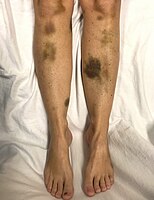
Photo from wikipedia
Systemic lupus erythematosus (SLE) is an autoimmune disease, characterized by multi-organ symptomatology. 16% of the patients with autoimmune thrombocytopenia have SLE and are associated with high mortality. Intravenous methylprednisolone or… Click to show full abstract
Systemic lupus erythematosus (SLE) is an autoimmune disease, characterized by multi-organ symptomatology. 16% of the patients with autoimmune thrombocytopenia have SLE and are associated with high mortality. Intravenous methylprednisolone or high-dose steroids are the first-line treatments in those patients who experienced life-threatening bleeding or have a severely low platelet count, whereas a second line includes splenectomy, as well as other immunosuppressive agents as monotherapy or combined therapy, including azathioprine, cyclophosphamide, cyclosporine, and mycophenolate mofetil. However, response rates of these therapies vary considerably. Rituximab (RTX) became a useful tool in the treatment of autoimmune diseases, due to the decrease of autoantibodies production. In addition, there is evidence that low doses of RTX (100 mg IV per week for 4 weeks) can have a similar effect compared to the standard dose. The objective of this study was to describe the response to low doses of RTX in patients with lupus-induced thrombocytopenia. We present a report of four female patients with newly diagnosed SLE, accompanied by purpuric syndrome and severe thrombocytopenia (< 30 × 109/L) as the clinical debut that was refractory to glucocorticoids (GC) therapy and treated with low doses of RTX. By week 5, complete response (> 100 × 109/L) was achieved in two patients, partial response (> 50 × 109/L) in 1 patient, and no response in one patient. There is little information on the treatment of SLE-associated autoimmune thrombocytopenia. The most extensive study found at the time of our search was the study of 10 Asian patients. They found that 80% of the patients responded by week four and maintained until week 24 of follow-up. At week 36, a follow-up for two patients showed relapse; this occurred on patients with the most disease duration (> 5 years) and was associated with a lower response rate. In contrast, our study with four patients found that half of them presented a complete response: one patient added concomitant therapy with azathioprine (AZA) and another patient without the concomitant therapy. A third patient with a partial improvement, this was seen by week five of treatment. Moreover, a fourth patient who did not have a response by week five of treatment presented a clinical response in subsequent appointments with a count of > 100 at week 24. Those patients who required concomitant use of AZA were patients who had positive antiphospholipid serology. The use of low-dose RTX for the management of severe thrombocytopenia refractory to GC in patients with SLE has a good response. It could be a safe, economical, and effective therapy.
Journal Title: Rheumatology International
Year Published: 2020
Link to full text (if available)
Share on Social Media: Sign Up to like & get
recommendations!